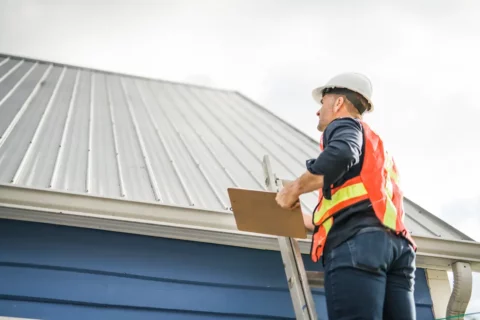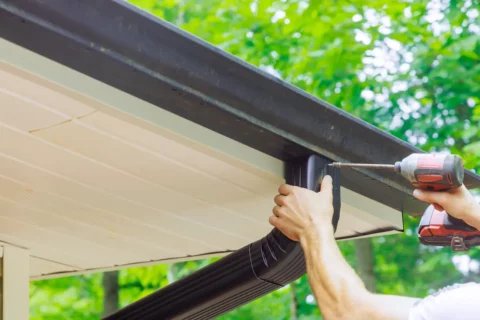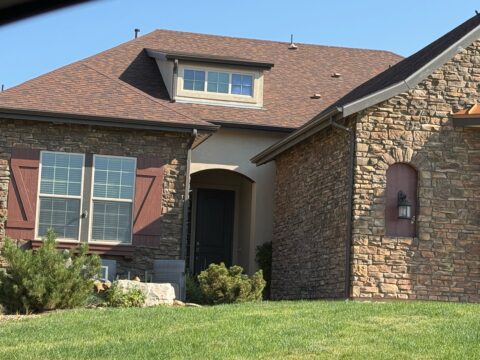In Denver, Colorado, where unpredictable weather is the norm, protecting your home’s roof is essential. Hailstorms are a common occurrence in this region, and they can wreak havoc on your roofing system. This blog will guide you on how to prevent roof hail damage in Denver, ensuring your roof weathers the storm effectively.
Understanding Hail Damage
What is hail damage?
Hail damage is the result of hailstones impacting and potentially causing harm to your roofing system. Hailstones are solid balls of ice that can range in size from tiny pellets to larger-than-life golf balls or even larger. When these ice projectiles rain down during a hailstorm, they can create a range of issues for your roof.
Hail damage isn’t always immediately evident, but over time, it can have serious consequences for your roof’s integrity and longevity. Here’s a closer look at the types of damage that hail can inflict:
- Dents: One of the most common forms of hail damage is dents on the surface of roofing materials. These dents can be subtle or quite pronounced, depending on the size and force of the hailstones. Asphalt shingles, metal roofs, and even wooden shakes can all suffer from hail-induced dents.
- Cracks: Hailstones, especially larger ones, can crack roofing materials. This is particularly concerning because cracks can lead to water infiltration. Over time, even a small crack can allow moisture to seep into your roof, causing leaks and further damage.
- Punctures: In severe cases, hailstones can puncture roofing materials. When this happens, it creates a direct path for water to enter your home. Punctures require immediate attention, as they can lead to significant leaks and costly repairs if not addressed promptly.
- Granule Loss: Hail impact can dislodge the protective granules on asphalt shingles. These granules play a vital role in shielding the shingles from the sun’s UV rays. Granule loss can accelerate shingle deterioration and shorten their lifespan.
Impact of hail on roofs
Understanding the potential consequences of hail damage is essential. Hail damage can lead to several problems for your roof and your home:
- Reduced Lifespan Hail damage weakens your roofing materials, making them more susceptible to wear and tear over time. This can significantly shorten the lifespan of your roof.
- Leaks: As mentioned earlier, cracks and punctures caused by hail can lead to leaks. These leaks can damage your home’s interior, including ceilings, walls, and insulation.
- Costly Repairs: Repairing hail damage can be expensive, especially if the damage is extensive. Ignoring hail damage can lead to even costlier repairs down the road.
- Insurance Premiums: Filing insurance claims for hail damage can cause your insurance premiums to increase. It’s essential to weigh the cost of repairs against potential premium hikes when deciding whether to make a claim.
Hail damage can have a significant impact on the condition and longevity of your roof. Recognizing the signs of hail damage and addressing it promptly can save you money and ensure your home remains protected from the elements. Regular roof inspections and maintenance are crucial in hail-prone areas like Denver, where being proactive can make all the difference in weathering the storm.
Preventative Measures
Regular roof inspections: Schedule professional inspections annually and after severe storms
Regular roof inspections are the first line of defense against hail damage. Consider hiring a professional roofing contractor for an annual check-up. They have the experience and knowledge to identify subtle signs of damage that may go unnoticed by an untrained eye. Additionally, after a severe hailstorm, it’s crucial to schedule an inspection promptly. Even if you don’t see visible damage, hail can weaken roofing materials, and a professional assessment can reveal hidden issues.
DIY inspections – look for visible signs of damage like dented or cracked shingles
While professional inspections are essential, homeowners can also conduct their own visual inspections. Start by checking your roof from the ground using binoculars to look for any obvious signs of damage like dented or cracked shingles. Be cautious when climbing onto your roof; it’s best to leave this to the professionals.
Roofing materials
Choose hail-resistant roofing materials such as impact-resistant shingles
When it’s time for a roof replacement or installation, opt for materials designed to withstand hail impact. Impact-resistant shingles, often rated as Class 4, are specifically engineered to resist hail damage. These shingles are constructed with a reinforced core that provides extra protection against hailstones.
Consider a Class 4 impact-resistant roofing system for added protection
If you live in an area prone to frequent hailstorms, consider investing in a Class 4 impact-resistant roofing system. This system includes not only impact-resistant shingles but also underlayment and other components designed to work together to safeguard your roof against hail damage.
Gutter maintenance
- Keep gutters clear of debris to ensure proper drainage
Proper drainage is crucial to prevent water from accumulating on your roof. Regularly clean your gutters and downspouts to ensure they are free of leaves, sticks, and other debris. Clogged gutters can lead to water backup and potential roof leaks. - Install gutter guards to prevent clogs
Gutter guards are a proactive solution to keep debris out of your gutters. They allow rainwater to flow freely while blocking leaves and debris. Installing gutter guards can significantly reduce the maintenance required to keep your gutters functioning correctly.
Storm-proofing your roof
- Secure loose roof components like flashing and vents
High winds associated with hailstorms can loosen roof components such as flashing and vents. Ensure these elements are securely fastened to prevent potential damage during a storm. - Reinforce weak points like roof valleys and edges
Roof valleys and edges are vulnerable areas that can be prone to leaks and damage during hailstorms. Reinforce these areas with additional waterproofing materials or consider installing metal flashing for added protection. - Consider storm-resistant roofing systems designed for hail-prone areas
Some roofing manufacturers offer systems specifically designed to withstand hail and severe weather conditions. These systems often include impact-resistant shingles, specialized underlayment, and enhanced installation techniques to ensure maximum durability.
By implementing these preventative measures, you can significantly reduce the risk of hail damage to your roof in Denver. Investing in the right materials, regular maintenance, and storm-proofing strategies will help your roof weather the storm and provide long-lasting protection for your home.
Post-Hail Inspection
Signs of damage to look for
After a hailstorm has passed through Denver, it’s crucial to conduct a thorough post-hail inspection of your roof to assess any potential damage. Here are the signs you should look for:
- Check for dented or cracked shingles
Examine your roof’s surface for any visible signs of damage to shingles or roofing materials. Hailstones can leave dents, cracks, or even punctures. Inspect the entire roof, paying close attention to areas where hail may have hit harder, such as slopes facing the storm. - Look for granule loss on shingles
Another indicator of hail damage is the loss of granules on asphalt shingles. If you notice areas where the granules have been knocked off, it’s a sign that hail impact has compromised the shingles’ protective layer. - Inspect gutters for dents or damage
Hail can also affect your gutter system. Check for dents or visible damage to gutters and downspouts. Damaged gutters may not effectively channel rainwater away from your roof, increasing the risk of leaks.
Importance of professional inspection
While conducting a DIY inspection is essential, it’s equally crucial to hire a professional roofing contractor to assess the extent of hail damage. Here’s why professional inspections are vital:
- Hidden Damage: Not all hail damage is immediately visible. Roofing professionals have the experience and knowledge to detect subtle signs of damage that may go unnoticed during a visual inspection.
- Accurate Assessment: Professionals can provide a detailed assessment of the damage, including the extent and severity. This information is crucial when filing insurance claims or planning for necessary repairs.
- Timely Repairs: Hail damage, if left unaddressed, can worsen over time. Prompt repairs can prevent further deterioration of your roofing system, potentially saving you money on more extensive repairs down the line.
- Insurance Claims: If you plan to file an insurance claim for hail damage, having a professional inspection report is often required by insurers. It provides documentation of the damage, supporting your claim and increasing the likelihood of a successful outcome.
- Safety: Climbing onto a damaged roof can be hazardous. Professionals have the proper safety equipment and training to conduct inspections safely.
During the professional inspection, the contractor will assess the condition of your roof, document the damage, and provide recommendations for repairs or replacements if necessary. They can also provide an estimate of the cost involved in addressing the damage.
In conclusion, a thorough post-hail inspection is essential to assess and address any damage to your roof in the aftermath of a Denver hailstorm. While you can perform a basic visual inspection, hiring a professional roofing contractor is crucial for a comprehensive assessment and ensuring that any necessary repairs are carried out promptly and effectively. This proactive approach will help protect your home from further damage and ensure the long-term integrity of your roof.
In Denver, protecting your roof from hail damage is not a luxury; it’s a necessity. Understanding the impact of hail, taking preventative measures, and conducting post-hail inspections will ensure your roof weathers the storm effectively. By investing in roof protection, you’ll safeguard your home and your peace of mind in this hail-prone region. For professional assistance and advice tailored to your roofing needs, contact 303 Roofer today. Don’t wait for the next hailstorm; prepare your roof for the challenges of Denver’s climate.




